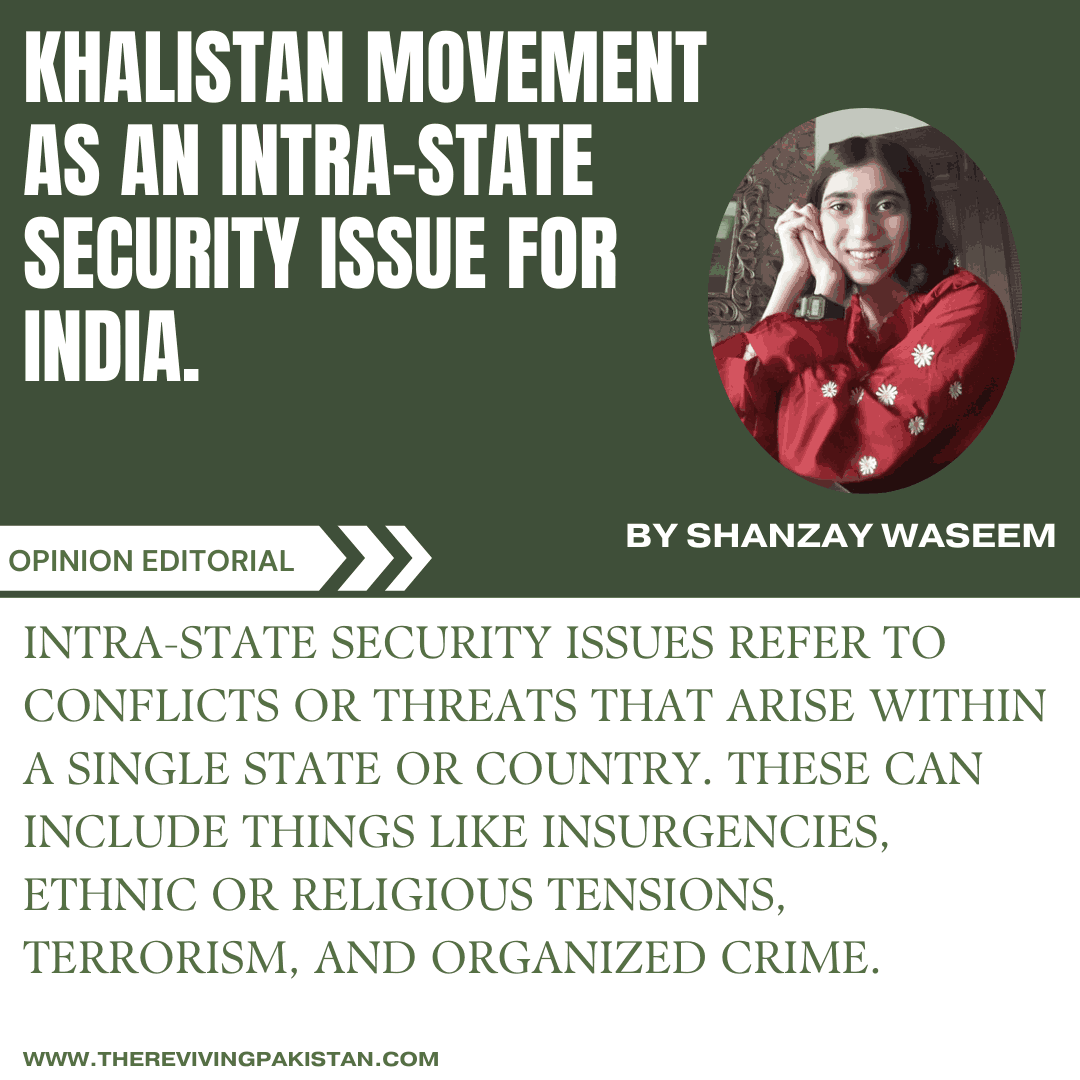About the Author(s)

Shanzay Waseem
Author is currently pursuing her Bachelor’s in Strategic Studies from the National Defence University, Islamabad. She has a keen interest in geopolitics, homeland security objectives, and current affairs.
Intra-state security issues refer to conflicts or threats that arise within a single state or country. These can include things like insurgencies, ethnic or religious tensions, terrorism, and organized crime. These intra-state security issues often pose significant challenges to the governance, stability, and well-being of citizens and the Khalistan movement in India is its prime example.
The Khalistan movement refers to the demand for a separate Sikh state, which primarily emerged in the 1980s as a result of perceived grievances among some sections of the Sikh community in Punjab, India. To trace it to its roots, this movement gained a track in the 1980s and early 1990s, leading to significant violence and instability in India, including the infamous Operation Blue Star. In 1984 the Sikh militant leader Jarnail Singh Bindrawale and his followers had fortified themselves in the golden temple in Amritsar leading to the then Prime Minister of India, Indira Gandhi calling emergency in the country and launching military operation to flush out the militants. The temple which is considered the holiest place in the Sikh religion was damaged and this deep-rooted grievances in the hearts of the Sikh community led to the assassination of India’s Prime Minister by her own Sikh bodyguards, Beant and Sawant Singh on 31 October 1984. There were subsequent anti-Sikh riots in India and mass destruction of Sikh property.
The demand for Khalistan has faded in the past years but has emerged recently because of the Sikh diaspora present in foreign countries. So the question arises in everyone’s mind that if the scale of the movement has varied over time how can Khalistan issue now become an intra-state security for India? And the answer to that question is that the movement is deeply rooted in Sikh identity, which can potentially exacerbate existing ethnic and religious tensions, particularly in the Punjab region. Furthermore,the extremist elements within the Khalistan movement may resort to violence and terrorism, leading to security challenges for both the state and its citizens. And to top it all, instability in Punjab, a strategically important region in India, could have broader implications for national security and stability.
The final blow to India’s reputation in the global community would appear from the international implications. And it has already started working its charm, as on 18 June,2023 Sikh Najjar a Canadian national and head of Guru Nanak gurdwara who was a Sikh separatist leader was shot dead in a busy car park in Canada, Vancouver. This incident lead to intensifying global tensions between India and Canada as the Prime Minister of Canada, Justin Trudeau stated on 18 september, 2023 that Canadian Intelligence agencies were ‘pursuing credible allegations of a potential link’ between ‘Indian government agents and the assassination of Nijjar’. Canada expelled an Indian diplomat from their country and in a tit for tat response India had removed a Canadian diplomat from their country.
This was the strategic blows ideology at an international level to India but further than that the new generations. Punjabi singers have incorporated the Khalistan issue as a referent object in their songs. Owing to their large fan base, abroad and in India itself, the Khalistan issue reaches to a wide audience. A very famous Punjabi singer “Sidhu Moose Wala” whose deaths cause is left as a murder mystery revolving around the case of gang rivalry or a pro-Khalistani supporter. As in 2020, December, Moose Wala released his album,Panjab: My Motherland in the support of the Indian farmers protest against the 2020 Indian agricultural Acts which featured clips of speeches made by pro-Khalistani supporter Bhalpur Singh Balbir in 1980s and Sikh militant Jarnail Singh Bindranwale.Also in an interview he had stated that Khalistan meant a pure place like it was under the rule of the Sikh ruler,Maharaja Ranjit Singh where people lived in peace. Lastly, the Khalistani issue is directly connected to the economic repercussions that India can potentially face in the future. As India is an Agrarian country and the farmer’s protests in India together with the suppressed emotions and deep rooted grievances of the Sikhs together can cause turmoil in the entire country leading to potential economic crisis in the country. Therefore, it is the best intra-state security issue for India to work upon before water rises above their heads leading to their fall.

